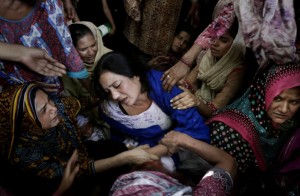Special to WorldTribune.com
Although the Obama Administration may well not recognize it, Pakistan is turning into the number one problem in fighting worldwide Islamic terrorism.
The massacre of 79, many of them children, by an Islamic terrorist group aiming at Christians on a community playground on Eastern Sunday – large numbers of Muslims were also killed and wounded – marks a new downturn in Pakistan.
The suicide bomber’s choice of a target in Lahore, Pakistan’s most sophisticated and second largest city, marks a new turn in the two decades of terrorist activity.
Lahore is capital of Punjab province with almost two thirds of Pakistan’s 185 million people. Noted for their pragmatism, Pujabis are widely represented in the Pakistan diaspora in the West and despite their religious differences, share much with their neighbors in bordering Indian Punjab.

It’s significant that the Jamaat ul-Ahrar, a splinter group of the Pakistan Taliban, which claimed credit for the attack, pledges allegiance to Daesh [The Islamic State, ISIS or ISIL].
Punjab is the power base of its native son Prime Minister Nawaz Sharif and his brother, the province’s chief minister and power broker. It had been largely spared both the growing terrorism of the last two decades and the military’s counteroffensives.
The Sharifs’ political success has depended on support from the more religious, and financial help from Saudi Arabia. Their civilian rule – Pakistan has spent more than half its existence under military rule – is now in jeopardy.
The military has been battling a growing insurgency from Islamic terrorists in Karachi, Pakistan’s huge port city. [In December 2014, terrorists, massacred 132 children at a military supported Army school in Peshawar, in the northwest frontier province adjoining Afghanistan.].
Pakistan’s losses, far greater than those of Western terrorist episodes in the West, have been largely ignored by the foreign media.
But this new turn of events, a strike at the heart of the Pakistan civilian regime, signals an increasing a growing threat to what has always been an unstable country. From its creation, carved from Muslim majority areas in British India in 1947 in a bloody partition of the Subcontinent, Pakistan originally included two disparate areas at the extremes of the Subcontinent separated by 1500 miles of the new India.
That was resolved with a brief war with India when Bangladesh broke away in 1972. But Pakistan was also bound by other contradictions.
Mohammed Ali Jinnah, the founding leader of the country, while basing his claims on the distinction of “two nations” in British India, one Muslim and the other Hindu, was like most of Pakistan’s leadership including its military not a devout Muslim.
Fanatical Muslim groups have become more and more active despite a campaign by the military to curb their sanctuaries in the Pakistan-Afghanistan areas.
Always keying foreign policy to its Indian neighbors with whom Pakistan has fought three wars since independence, the nation has drifted in and out of an alliance with the U.S. since Partition.
With the U.S.’ growing ties to India, anti-Americanism is on the rise in Pakistan.
Washington policy makers had generally seen Pakistan as a bloc to former Soviet – and even older Russian imperial – efforts to reach the Indian Ocean and as a counter to Jawaharlal Nehru’s alliance with the Soviets.
After the Soviet occupation of Afghanistan at the end of 1979, the U.S. used Pakistan as a base to oust Moscow in 1980-82 with the help of NATO allies. After the 9/11 [2001] attack by Osama Bin-Laden from his base in Afghanistan, Pakistan was a resource to oust the Taliban regime.
If the Pakistan military is unable to curb the growing terrorist movements, Pakistani fanatics could well become the most important recruits for Daesh and its attempt to create a worldwide Muslim terrorist network.
Contrary to much that has been written, Daesh’s recruits are largely from relatively privileged disaffected Muslims, not the impoverished masses.
The Pakistanis’ large English-speaking minority and its large body of technical immigrants in the West – widely represented in Silicon Valley, for example – it could add immeasurably to Washington’s effort to curb growing international terrorism.
Sol W. Sanders, ([email protected]), is a contributing editor for WorldTribune.com and Geostrategy-Direct.com.

